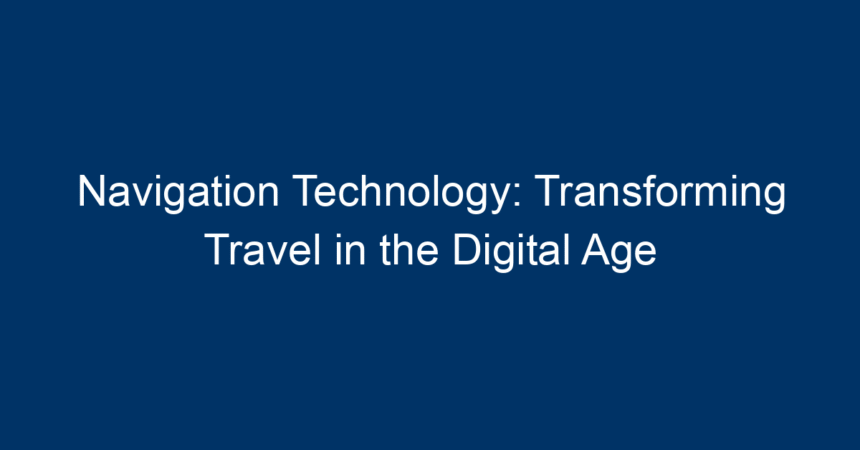In a world that is increasingly interconnected, navigation technology has emerged as a pivotal force in shaping the way we travel. From mobile apps that provide real-time directions to advanced GPS systems built into our vehicles, the landscape of navigation has transformed significantly in the digital age. This article delves into the evolution, significance, and future of navigation technology, highlighting how it continues to revolutionize travel experiences for millions worldwide.
The Evolution of Navigation Technology
Historical Context
Navigation technology has a rich history that dates back to ancient civilizations. Initially, travelers relied on natural landmarks and celestial bodies for guidance. With the advent of the compass in the Middle Ages, maritime navigation saw significant advances, allowing for safer sea travel. The introduction of maps provided a foundation for recorded routes, but it wasn’t until the 20th century that modern navigation systems began to take form.
The GPS Revolution
The Global Positioning System (GPS), launched by the United States Department of Defense in the late 1970s, marked a watershed moment in navigation technology. Utilizing a network of satellites, GPS allows users to determine their exact location anywhere on Earth, revolutionizing personal and commercial travel alike. Today, GPS systems are integral to smartphones, vehicles, and even outdoor equipment like hiking GPS units.
The Rise of Smart Navigation
The turn of the 21st century brought about the rise of smart navigation technologies. Applications such as Google Maps and Waze leverage real-time data to provide not only directions but also valuable information about traffic conditions and alternative routes. These platforms have transformed navigation from a linear process into an interactive experience.
How Navigation Technology is Transforming Travel
Improved Accuracy and Efficiency
One of the most significant advantages of modern navigation technology is its accuracy. GPS-enabled devices can locate a user within a few meters, ensuring that travelers can maneuver around unexpected obstacles such as road closures or heavy traffic. This precision leads to fuel savings and efficient travel times, making journeys not only easier but also more economical.
Enhanced Safety Features
Safety has always been paramount in travel. Navigation technology has advanced safety protocols with features such as live traffic updates, accident reports, and even hazard alerts. For example, applications can automatically reroute drivers away from potential dangers, reducing the likelihood of accidents and ensuring a safer travel experience.
Personalization of Travel Experiences
The evolution of navigation technology has also brought about a more personalized approach to travel. By analyzing user data and preferences, navigation apps offer customized routes based on individual interests. Whether you prefer scenic drives or the quickest paths, navigation technology can adjust to accommodate your unique travel style.
Integration with Other Technologies
Modern navigation technology doesn’t exist in isolation; it integrates seamlessly with various other innovations. For instance, the advent of connected vehicles means that navigation systems can communicate with traffic signals, optimizing driving routes in real time. Moreover, travel apps can tie in hotel bookings and restaurant reservations, creating a cohesive travel experience from start to finish.
The Impact of Navigation Technology on Different Segments
Urban Mobility
In urban environments, navigation technology plays a crucial role in managing traffic flow and facilitating public transportation. Real-time data helps commuters find the quickest routes using buses or trains. Ride-sharing services like Uber and Lyft rely heavily on navigation technology to match passengers with nearby drivers, enhancing the efficiency of urban travel.
Tourism and Exploration
For tourists, navigation technology is a game changer. Travelers can explore new cities with ease, using their smartphones to uncover hidden gems and local attractions. Augmented reality (AR) apps now provide guided tours, superimposing information about nearby landmarks directly onto the user’s screen.
Outdoor and Adventure Activities
From hikers to mountain bikers, outdoor enthusiasts depend on specialized navigation technology. Sporting devices equipped with GPS allow users to track their routes in real time, providing insights into distance covered, altitude, and pace. These applications ensure that adventurers can enjoy the great outdoors while staying safe and informed.
Challenges and Limitations
Dependency on Technology
While navigation technology offers numerous benefits, it also raises concerns about over-dependence. Travelers might neglect traditional navigation skills, such as reading maps or understanding cardinal directions. In scenarios where GPS signals are weak or unavailable, this reliance could pose challenges.
Data Privacy Concerns
With the integration of smart technologies comes the issue of data privacy. Many navigation applications collect user data to provide personalized experiences, but this practice can also raise concerns about how that data is used and stored. Users must be vigilant about their privacy settings and conscious of the information they share.
Infrastructure Limitations
Despite significant advancements, not all areas have reliable GPS coverage. Rural or remote locations might face challenges due to a lack of infrastructure supporting sophisticated navigation technologies. Continued investment in technology and infrastructure is necessary to guarantee equitable access.
The Future of Navigation Technology
AI and Machine Learning
As artificial intelligence (AI) and machine learning continue to evolve, the future of navigation technology looks promising. Predictive analytics could advance to gauge traffic patterns, providing even more accurate forecast-based routing. This means travelers could plan better by anticipating congestion before they even hit the road.
Autonomous Vehicles
Another evolution lies in the rise of autonomous vehicles, which depend on advanced navigation technology for safe operation. Self-driving cars will rely on real-time data and AI to interpret their surroundings, making travel more efficient and reducing the chances of human error.
Sustainable Travel Solutions
With an increasing emphasis on sustainability, navigation technology will also need to adapt to promote eco-friendly travel solutions. Offering routes that minimize emissions or recommending public transportation can ensure that travelers make responsible and sustainable choices.
Conclusion: Embracing the Future of Travel
As we stand on the cusp of a new frontier in travel, navigation technology is more than just a tool; it is an enabler of experiences and adventures. Embracing advancements in navigation technology can lead to safer, more efficient, and personalized travel experiences.
To fully leverage the benefits of navigation technology, travelers should stay informed about the latest tools and trends. Whether it’s utilizing the newest app features or understanding privacy implications, being proactive will enhance your travel journey.
As navigation technology continues to evolve, it promises to weave itself even deeper into our travels, making the world more accessible than ever before. So, prepare to chart your course in this digital age—adventure awaits at every turn!




